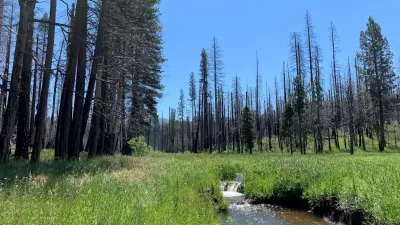The National Aquarium wants to recreate the tidal marshes that once lined the city's waterfront.

Baltimore's Inner Harbor "was once lined with tidal salt marshes, only a few feet deep and teeming with aquatic life," writes Elizabeth Shwe. But as the city industrialized, those marshes were dredged to make room for deepwater shipping ports. "Now the National Aquarium is trying to recreate those rich tidal marshes of yore by building an oasis of floating wetlands at the aquarium’s campus off Pratt Street."
"Floating wetlands can bring natural habitats back to the harbor, such as a nursery for hatching fish and a safe shallow place for blue crabs to shed their shells," as well as improve water quality and provide educational opportunities for local residents. Jack Cover, general curator of living exhibits at the National Aquarium, "has been maintaining a 400-square-foot floating wetland prototype for four years, testing the durability of materials in the Harbor and gathering information on what animals will inhabit this habitat to prepare for the aquarium’s larger project." He says "[f]loating wetlands are also examples of how low-tech green infrastructure can be added to a waterfront city to help clean air and water."
Cover hopes "[l]earning more about the harbor could motivate people to make small changes in their lives such as planting more trees to expand green infrastructure or advocating for better environmental legislation."
FULL STORY: Floating Wetlands Planned for Inner Harbor to Revive Urban Ecosystems, Clean Water

Planetizen Federal Action Tracker
A weekly monitor of how Trump’s orders and actions are impacting planners and planning in America.

Restaurant Patios Were a Pandemic Win — Why Were They so Hard to Keep?
Social distancing requirements and changes in travel patterns prompted cities to pilot new uses for street and sidewalk space. Then it got complicated.

Maui's Vacation Rental Debate Turns Ugly
Verbal attacks, misinformation campaigns and fistfights plague a high-stakes debate to convert thousands of vacation rentals into long-term housing.

In California Battle of Housing vs. Environment, Housing Just Won
A new state law significantly limits the power of CEQA, an environmental review law that served as a powerful tool for blocking new development.

Boulder Eliminates Parking Minimums Citywide
Officials estimate the cost of building a single underground parking space at up to $100,000.

Orange County, Florida Adopts Largest US “Sprawl Repair” Code
The ‘Orange Code’ seeks to rectify decades of sprawl-inducing, car-oriented development.
Urban Design for Planners 1: Software Tools
This six-course series explores essential urban design concepts using open source software and equips planners with the tools they need to participate fully in the urban design process.
Planning for Universal Design
Learn the tools for implementing Universal Design in planning regulations.
Heyer Gruel & Associates PA
JM Goldson LLC
Custer County Colorado
City of Camden Redevelopment Agency
City of Astoria
Transportation Research & Education Center (TREC) at Portland State University
Jefferson Parish Government
Camden Redevelopment Agency
City of Claremont




























